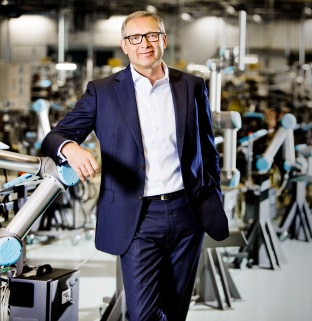How Robots Will Remake the Economy
As predicted, robots are indeed taking over the world. Rather than a Terminator-style uprising, however, what is coming into view is a more collaborative and far-reaching world of robotic automation.
“The era of the freestanding, rigid, hard metal robot is the past, not the future,” says Dr. Donald Ingber, founding director of Harvard University’s Wyss Institute. “What’s really going to change what robotics is like, from an industrial perspective at least, is the idea of many small, lightweight robots seamlessly integrated with the human body or working together.”
Martin Ford, a futurist and author of Rise of the Robots: Technology and the Threat of a Jobless Future, agrees. “The revolution isn’t about robots that look like C3PO running around doing everything people do,” he says. “This revolution is something that’s going to extend throughout the economy—and transform a great many white-collar jobs that don’t involve any physical manipulation at all. At this point, it’s inevitable.”
“This revolution is something that’s going to extend throughout the economy. At this point, it’s inevitable.”
—Martin Ford, author of Rise of the Robots
Pace Race
Robots are already pretty much everywhere, says Rick Brookshire, director of product development at Epson Robots, the robotics and manufacturing department of the $10 billion Seiko Epson company. “Nearly all manufacturing industries are using robots in some way today,” he says.
Epson-designed robots are already at work on thousands of different applications, including manufacturing Seiko wristwatches. “The Epson watch lines involve hundreds of robots working together to build small products with hundreds of components, where the end result is something smaller than 1.5 inches by 1.5 inches,” he says.
Advances in artificial intelligence (AI) are bolstering the capabilities of robots used in manufacturing settings, says Jürgen von Hollen, president of Universal Robots. The Denmark-based company makes and sells collaborative robots, or “cobots,” designed to work hand-in-hand with human operators on a wide range of tasks. Third-party developers offer products that allow the robots to accomplish tasks such as monitoring changing workspace conditions and predicting and diagnosing failure conditions.
“We need to see the robot as a tool that works right next to us in close collaboration, not simply as a machine that takes over manual labor and gets people fired,” Mr. von Hollen says. Employees with no prior programming experience are being promoted from operators to robot programmers, he adds. “If we can mix people and machines in the right way on the factory floor, we see enormous potential there for value adding, rather than just cranking up production levels.”
“I see robots being an integral part of human lives over the coming quarter century.”
—Rick Brookshire, director of product development, Epson Robots
In sectors with a sizable and well-established foothold, such as the automotive industry, robotics are anything but static. “With all of the innovation being done in car sensors, cameras and visual monitoring, and with electric and autonomous vehicles, we’re seeing new robotics challenges at an increasing pace,” Mr. Brookshire says.
Lightning growth is expected across different robotics markets in the coming years. The global industrial market will more than double, for example, growing from $35.6 billion in 2017 to $97.4 billion in 2026, according to a 2018 Research and Markets study. Meanwhile, the medical and military robotics markets will both more than triple by 2027 to $22.1 billion and $53.9 billion Share on X respectively, according to Markets and Markets and Zion Market Research.
These may, in fact, be conservative estimates. If another recession does hit, it might accelerate robots’ ascent, Mr. Ford explains. Historically, companies tend to double down on tech investments during a recession, as a means to trim labor costs. Some companies see no reason to wait for a recession to do so, however. In July, for instance, Deutsche Bank announced plans to cut 18,000 employees by 2022, shaving labor costs by €6 billion annually. To offset that staff reduction, €13 billion worth of technology investments will be made through 2022. The bank’s former CEO, John Cryan, said in 2017 that “we have people behaving like robots doing mechanical things. Tomorrow, we’re going to have robots behaving like people.”
“We need to see the robot as a tool that works right next to us in close collaboration, not simply as a machine that takes over manual labor and gets people fired.”
—Jürgen von Hollen, president of Universal Robots
Inch by Inch
Due to the repetitive nature of tasks, finance and retail are two sectors particularly well poised for a massive robotics takeover, says Mr. Ford. Indeed, 2018 was the first time Amazon hired fewer holiday seasonal workers for its warehouses than the year before. The global retail giant began adding robots to its warehouses in 2012 and now has more than 100,000 in action at more than 26 fulfillment centers worldwide.
Warehouse robots and AI accountants have swiftly entered the mainstream, in part because some repetitive tasks have few qualitative or ethical demands. In the medical field, for instance, strict regulatory oversight and the need for clinical trials often slow the development and implementation of robotics automation, says Mr. Ingber. (He also points to construction as another industry that has traditionally been risk averse about such advances.)
Last year, the U.S. Food and Drug Administration issued clearance for ReStore, the first soft robotic system for stroke patients. It helps people improve their gait. Unlike the imposing mechanical arm of the assembly-line robot, soft robotics are built with highly pliable materials and designed to mimic human movements. Several Wyss Institute faculty are at work developing robotics capable of grasping and handling delicate items that could be put to use in operating rooms or warehouses.
In construction, the still nascent field of swarm robotics could one day transform how structures are built—and the role humans play in the industry. “With swarm robotics, a group of autonomous robots is programmed to work collectively to accomplish a desired task,” Mr. Ingber explains.
The thought of groups of robots collaborating independently seemed “kind of a dream” just a decade ago, he says. But last year, the institute’s Radhika Nagpal and Justin Werfel completed a prototype capable of inserting and interweaving large sheets of metal to create a retaining wall along water, with robots using their own body weight to hammer materials into the ground. “I don’t think we’re that far off from programming many of them working together to build architecture, cities and environments,” he says.
To make the leap from prototype to products, businesses developing robots will have to tackle the challenges of scaling manufacturing, and in the case of medical robots, miniaturizing batteries and increasing biocompatibility. “There is also a dearth of funding in the robotics area, with a relatively small venture capital community compared to biotech,” he says. But the robot revolution has arrived, with some (including Mr. Ford) predicting large-scale change within the next decade.
Mr. Brookshire views robotics through a somewhat longer lens: “I see robots being an integral part of human lives over the coming quarter century,” he says. “With the next step into collaborative robots, humans and robots are getting closer. They’re already working together side by side more often today than ever in the past.”
This article appeared in the Winter 2020 issue of Insigniam Quarterly, with the headline “Automation: Robots Rising.” To begin receiving IQ, go here.





